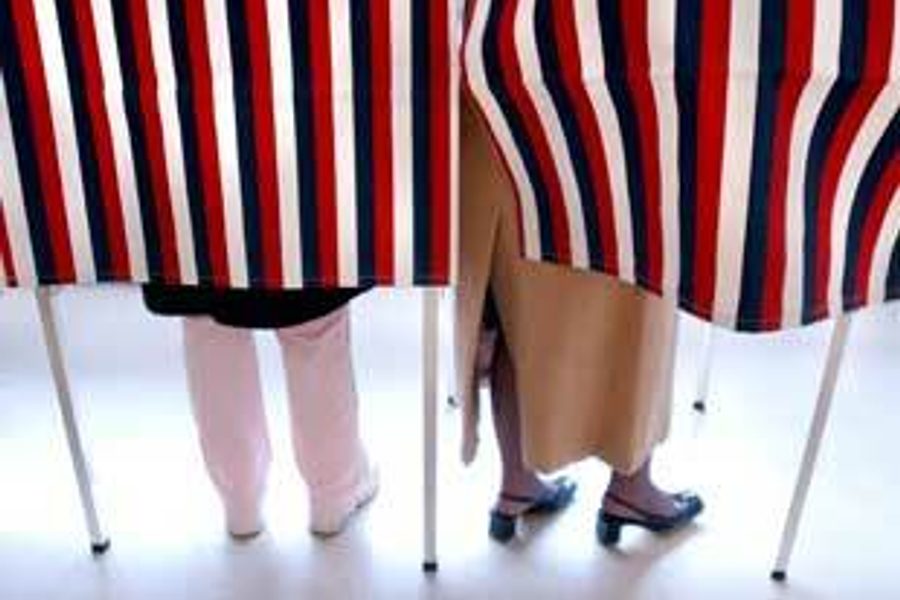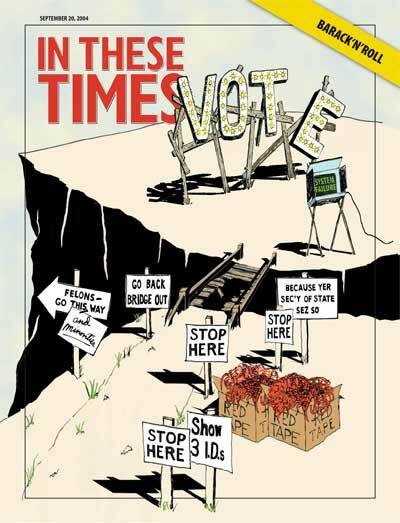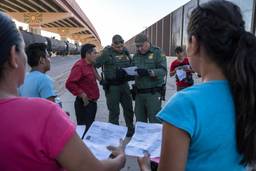Sum of a Glitch
Evidence shows that machines might be the real swing voters this November
Bev Harris

In the Alabama 2002 general election, machines made by Election Systems and Software (ES&S) flipped the governor’s race. Six thousand three hundred Baldwin County electronic votes mysteriously disappeared after the polls had closed and everyone had gone home. Democrat Don Siegelman’s victory was handed to Republican Bob Riley, and the recount Siegelman requested was denied. Three months after the election, the vendor shrugged. “Something happened. I don’t have enough intelligence to say exactly what,” said Mark Kelley of ES&S.
When I began researching this story in October 2002, the media was reporting that electronic voting machines are fun and speedy, but I looked in vain for articles reporting that they are accurate. I discovered four magic words, “voting machines and glitch,” which, when entered into a search engine, yielded a shocking result: A staggering pile of miscounts was accumulating. These were reported locally but had never been compiled in a single place, so reporters were missing a disturbing pattern.
I published a compendium of 56 documented cases in which voting machines got it wrong.
How do voting-machine makers respond to these reports? With shrugs. They indicate that their miscounts are nothing to be concerned about. One of their favorite phrases is: “It didn’t change the result.”
Except, of course, when it did:
- In the 2002 general election, a computer miscount overturned the House District 11 result in Wayne County, North Carolina. Incorrect programming caused machines to skip several thousand party-line votes, both Republican and Democratic. Fixing the error turned up 5,500 more votes and reversed the election for state representative.
- This crushing defeat never happened: Voting machines failed to tally “yes” votes on the 2002 school bond issue in Gretna, Nebraska. This error gave the false impression that the measure had failed miserably, but it actually passed by a 2-to-1 margin. Responsibility for the errors was attributed to ES&S, the Omaha company that had provided the ballots and the machines.
- According to the Chicago Tribune, “It was like being queen for a day — but only for 12 hours,” said Richard Miholic, a losing Republican candidate for alderman in 2003 who was told that he had won a Lake County, Illinois, primary election. He was among 15 people in four races affected by an ES&S vote-counting foul-up.
- An Orange County, California, election computer made a 100 percent error during the April 1998 school bond referendum. The Registrar of Voters Office initially announced that the bond issue had lost by a wide margin; in fact, it was supported by a majority of the ballots cast. The error was attributed to a programmer’s reversing the “yes” and “no” answers in the software used to count the votes.
- A computer program that was specially enhanced to speed the November 1993 Kane County, Illinois, election results to a waiting public did just that — unfortunately, it sped the wrong data. Voting totals for a dozen Illinois races were incomplete, and in one case they suggested that a local referendum proposal had lost when it actually had been approved. For some reason, software that had worked earlier without a hitch had waited until election night to omit eight precincts in the tally.
- A squeaker — no, a landslide — oops, we reversed the totals — and about those absentee votes, make that 72-19, not 44-47. Software programming errors, sorry. Oh, and reverse that election, we announced the wrong winner. In the 2002 Clay County, Kansas, commissioner primary, voting machines said Jerry Mayo ran a close race but lost, garnering 48 percent of the vote, but a hand recount revealed Mayo had won by a landslide, receiving 76 percent of the vote.
The excuses given for these miscounts are just as flawed as the election results themselves. Vendors have learned that reporters and election workers will believe pretty much anything, as long as it sounds high-tech. They blame incorrect vote counts on “a bad chip” or “a faulty memory card,” but defective chips and bad memory cards have very different symptoms. They don’t function at all, or they spit out nonsensical data.
In the November 2002 general election in Scurry County, Texas, poll workers got suspicious about a landslide victory for two Republican commissioner candidates. Told that a “bad chip” was to blame, they had a new computer chip flown in and also counted the votes by hand — and found that Democrats actually had won by wide margins, overturning the election.
Voting machine vendors claim these things are amazingly accurate. Bob Urosevich, who has headed three voting machine companies under five corporate names, said in 1990 that his company’s optical-scan machines had an error rate of only “one-thousandth of 1 percent.”
At that time Urosevich was with ES&S (then called American Information Systems). Recently, the same Urosevich (now president of Diebold Election Systems) gave an even more glowing endorsement of his company’s touch-screen accuracy.
“Considering the magnitude of these elections, which includes more than 870,000 registered voters within the four Maryland counties, we are very pleased with the results as every single vote was accurately counted,” he said.
In 1992, when Chuck Hagel accepted his position as chairman of American Information Systems, he offered a rousing endorsement: “The AIS system is 99.99 percent accurate,” he assured.
But do these claims hold up?
According to the Wall Street Journal, in the 2000 general election an optical-scan machine in Allamakee County, Iowa, was fed 300 ballots and reported 4 million votes. The county auditor tried the machine again but got the same result. Eventually, the machine’s manufacturer, ES&S, agreed to have replacement equipment sent. Republicans had hoped that the tiny but heavily Republican county would tip the scales in George W. Bush’s favor, but tipping it by almost 4 million votes attracted national attention.
November, 2003: Officials from Boone County, Indiana, wanted to know why their MicroVote machines counted 144,000 votes cast when only 5,352 existed.
Better than a pregnant chad — these machines can actually give birth.
In the 1996 McLennan County, Texas, Republican primary runoff, one precinct tallied about 800 votes, although only 500 ballots had been ordered.
“We don’t think it’s serious enough to throw out the election,” said county Republican Party Chairman M.A. Taylor. Error size: 60 percent.
Here’s a scorching little 66 percent error rate: Eight hundred and twenty-six votes in one Tucson, Arizona-area precinct simply evaporated, remaining unaccounted for a month after the 1994 general election. No recount appears to have been done, even though two-thirds of voters did not get their votes counted. Election officials said the vanishing votes were the result of a faulty computer program. Apparently, the software programming error and the person who caused it are still at large.
Some voters aren’t so sure that every single vote was accurately counted during the 2002 general election in Maryland.
According to the Washington Times, Kevin West of Upper Marlboro, who voted at the St. Thomas Church in Croom, said, “I pushed a Republican ticket for governor and his name disappeared. Then the Democrat’s name got an ‘X’ put in it.”
No one will ever know whether the Maryland machines counted correctly because the new Diebold touch-screen system is unauditable.
Tom Eschberger became a vice president of ES&S not long after he accepted an immunity deal for cooperating with prosecutors in a case against Arkansas Secretary of State Bill McCuen, who pleaded guilty to taking kickbacks and bribes in a scheme related to computerized voting systems.
Eschberger reported that a test conducted on a malfunctioning machine and its software in the 1998 general election in Honolulu, Hawaii, showed the machine worked normally. He said the company did not know that the machine wasn’t functioning properly until the Supreme Court ordered a recount, when a second test on the same machine detected that it wasn’t counting properly.
“But again, in all fairness, there were 7,000 machines in Venezuela and 500 machines in Dallas that did not have problems,” he said.
Really?
Dallas, Texas A software programming error caused Dallas County, Texas’ new, $3.8 million high-tech ballot system to miss 41,015 votes during the November 1998 election. The system refused to count votes from 98 precincts, telling itself they had already been counted. Operators and election officials didn’t realize they had a problem until after they’d released “final” totals that omitted one in eight votes.
In one of the nonsensical answers that we hear so often from vendors, ES&S assured us that votes were never lost, just uncounted.
The company took responsibility and was trying to find two apparently unrelated software bugs, one that mistakenly indicated precinct votes were in when they weren’t, and another that forgot to include 8,400 mail-in ballots in the final tally. Democrats were livid and suspicious, but Tom Eschberger said, “What we had was a speed bump along the way.”
Caracas, Venezuela In May 2000, Venezuela’s highest court suspended elections because of problems with the tabulation for the national election. Venezuela sent an air force jet to Omaha to fetch experts from ES&S in a last-ditch effort to fix the problem. Dozens of protesters chanted, “Gringos get out!” at ES&S technicians. Venezuelan President Hugo Chávez accused ES&S of trying to destablize the country’s electoral process. Chávez asked for help from the U.S. government because, he said, the United States had recommended ES&S.
Some people, when you give them the short but horrifying version of the electronic voting issue, insist on minimizing the problem. You tell them about an election that lost 25 percent of its votes, and they say, “That’s just an isolated incident.” When you add that another election had a 100 percent error, they call it a “glitch.” When you tell them a voting machine was videotaped recording votes for the opposite candidate than the one selected, they say, “There are problems in every election.”
No. We are not talking about a few minor glitches. These are real miscounts by voting machines, which took place in real elections. Almost all of them were caused by incorrect programming, whether by accident or by design.
Is this not alarming? These voting systems have miscounted our votes, flipping elections even when they are not particularly close. Even more alarming: We have no idea how many miscounts go unnoticed.
To correct current procedural flaws, we need to bring in the right kinds of experts — auditors — and we need to keep the system simple.
Here are some procedural safeguards we should consider:
- Verify the machine tally while still at the polling place. Run a report of the tally from the polling place before phoning, modeming or driving anything to the county. Post this report on the door of the precincts and make copies available to the press.
- Compare the polling-place tally with the matching totals assigned by the central county office. If there is a discrepancy, pull out the paper ballots and do an audit.
- Provide clearly delineated accounting for the votes that appear separately from the precinct totals, like absentee votes and provisional votes. Polling-place tallies should always match what is posted at the polling place. Separate the other votes cleanly and record them in a way that is easily understandable for everyone.
- Hand audits must be a routine part of every election, not just used for recounts. Hand-audit any anomalies.
- Make “random” spot checks truly random by using a transparent and public method for random selection.
- Allow the press, and any citizen, to audit if they pay for it. If they discover that the election was miscounted, reimburse them. Find ways to do these audits inexpensively.
- Allow each party to select a handful of precincts to hand-audit. Discretionary audits shine light into any precincts deemed suspicious.
- Require audits for insufficient randomness (e.g., three candidates each get 18,881 votes; voters arrived in alphabetical order).
- Require that the audit be expanded if discrepancies are spotted, whether or not the discrepancy would overturn the election.
- When voting machines miscount, require that fact be disclosed. If it is the fault of the vendor, require such failures to be disclosed to prospective buyers.
- Consider a 100 percent audit of the paper ballots. It may be easier and cheaper to do a 100 percent audit than to counter the political tricks that will arise when we introduce judgment (like what constitutes an “anomaly”) into a robust spot-checking procedure.
Taking back our vote is not something we can depend on others to do for us. This requires the top talent we have. Nothing less will do. This job needs you.
What are we fighting for? Simply this, and we must accept nothing less: We want voting systems to produce voter-verified paper ballots, and those ballots must be considered the legal record when used for recounts and audits. We must use robust fraud-deterring auditing methods, and we must place a much higher priority on catching and correcting software miscounts.
We need a temporary interim solution, so we can be confident that our votes are secure in the next elections. We also need a long-term solution, a bill passed by Congress.
We need to develop public policy, auditing procedures, and tamper-proof voting machines based on input from experts in a variety of fields, and we must not allow our collective common sense to be overridden by profit motives, or the desire to save face because of past mistakes.

I hope you found this article important. Before you leave, I want to ask you to consider supporting our work with a donation. In These Times needs readers like you to help sustain our mission. We don’t depend on—or want—corporate advertising or deep-pocketed billionaires to fund our journalism. We’re supported by you, the reader, so we can focus on covering the issues that matter most to the progressive movement without fear or compromise.
Our work isn’t hidden behind a paywall because of people like you who support our journalism. We want to keep it that way. If you value the work we do and the movements we cover, please consider donating to In These Times.




